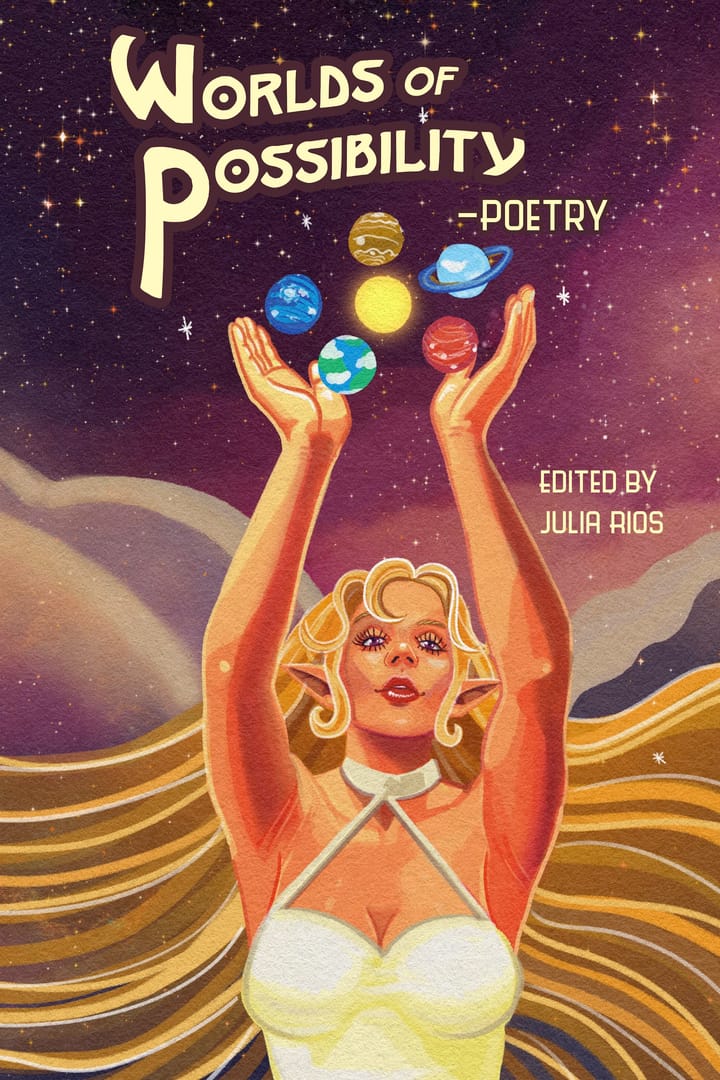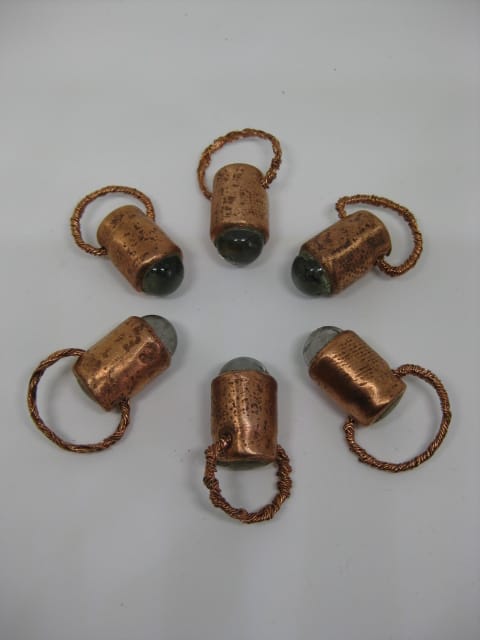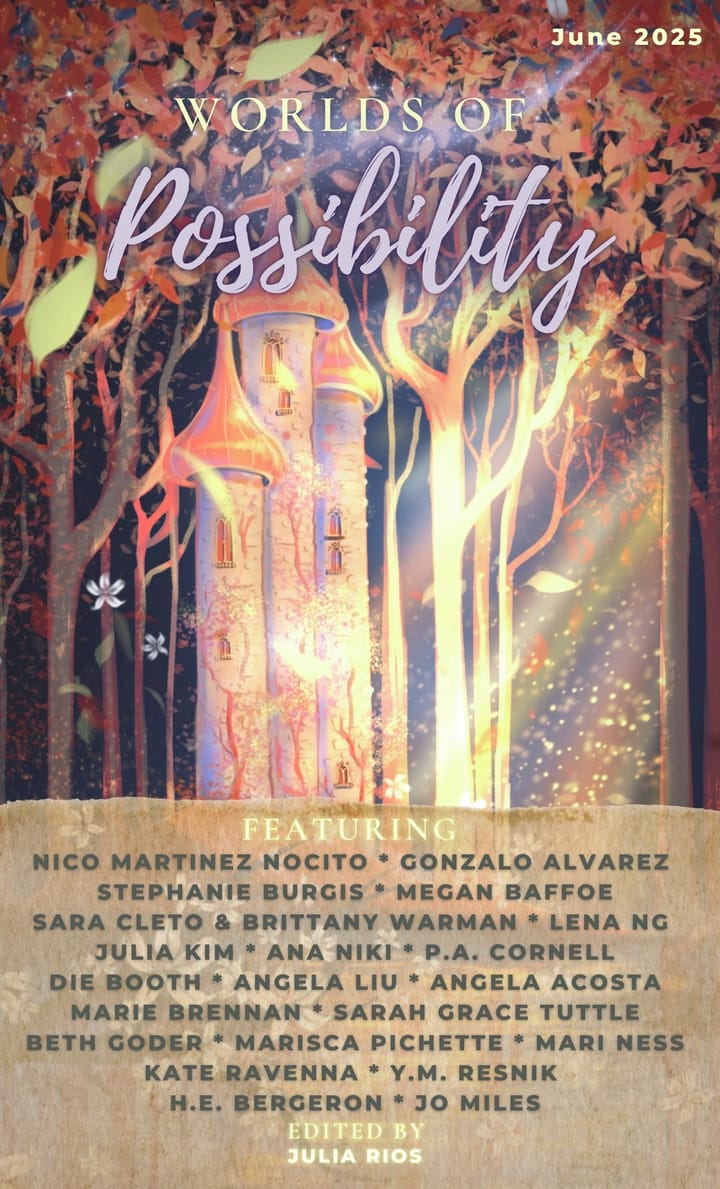Interview with Die Booth
This is the transcript of an interview with Die Booth from the June 2025 issue of Worlds of Possibility. You can listen to both the story and the interview on the OMG Julia Podcast.
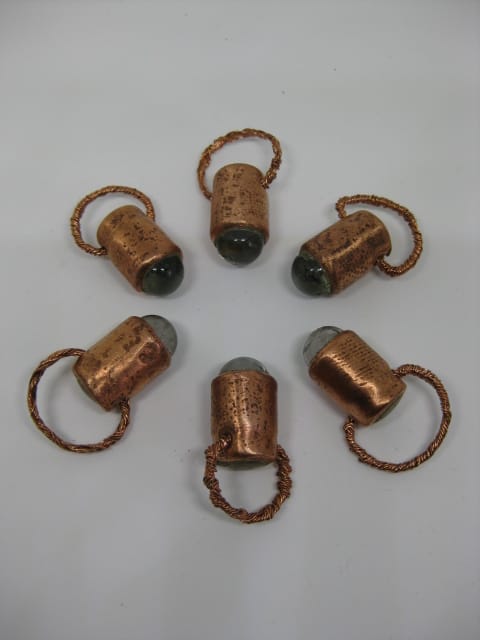
This is the transcript of an interview with Die Booth from the June 2025 issue of Worlds of Possibility. If you have not already read his story, you can do that here, and you can listen to both the story and the interview on the OMG Julia Podcast.
Listen to "Die Booth - Story and Interview" on Spreaker.Julia: I'm here with Die Booth, the author of "Warning, Cats Eyes Removed". Welcome, Die.
Die: Hi, thank you very much for having me on.
Julia: First of all, I want to get this out of the way right at the start. In the US, we don't have cats eyes. So for anyone listening in the US or reading this story in the US, cats eyes are reflective road studs. I think in the US we would just call them reflectors, but the things that we have aren't what you're writing about. So the first thing I would love for you to tell us, Die, is A) a little bit about who you are, and then B) explain what cats eyes are and why you're so drawn to them that you've both written a story and made art with them.
Die: I'm Die Booth. I'm a writer from the northwest of England, writing mostly speculative fiction. I write a lot of horror, folk horror, and literary fiction, whatever that means. So, yeah, I've got a few books out. I've been mostly self-publishing at the moment, but I've had loads of short stories in various places. So that's me.
And yeah, so: cats eyes. I think now we don't really call them cats eyes over here anymore either. It's kind of an archaic term. They're known as road studs now, I think. And they're like square plastic things now. They're not the the round glass ones that I'm writing about here. So really I wrote this as kind of a nostalgia thing for me about childhood because I always used to love being driven at night when I was a kid, and seeing the cats eyes and spotting all the different colours, because they'd have — I don't know if it's the same in the US, I assume it is — the white ones to mark the lanes, and there's green, there's amber, there's red to mark kind of like slipways and stuff. In the past, they were these little round, basically glass balls in casing. That would be copper for the older ones that I think got sort of phased out in the 80s, I believe. Or after that, they were just like black, painted metal or rubber.
I don't know how much to share of my personal life here, but when I was a lot younger, when I was about 20, my partner at the time knew that I had a bit of a nostalgia thing for when I was a kid, and he went and he got me a cats eye from a road and gave it to me as a gift, which was probably massively illegal, but it was a siding one. It wasn't dangerous. I think they get replaced, or they got replaced quite frequently anyway, as they'd sort of break or get dirty as traffic went over them.
And so I knew what these things looked like when they came out of the casing. So fast forward sort of 20-odd years, and they're all getting removed and all these signs start appearing in the UK saying ‘Warning: Cats Eyes Removed' and apparently these signs didn't last for long because visitors to the UK were getting really distressed by these signs, not knowing what cats eyes were, and going, ‘what? cats eyes removed? what on earth is what does this mean?’ and thinking it was some kind of like animal cruelty term or whatever.
So that's where the title came from and that's where the inspiration for this story came from.
Julia: It's really funny that you say that they had to take the signs down because I know I'm also going to have to put clear disclaimers all over the issue because in the US we don't have that term and we don't know what they are. So I know there are going to be a lot of readers who see that title and automatically are like, is this a story about cats being harmed? Which it's absolutely not.
Die: I'm wondering if that was a good title to give it now, but that's the reasoning behind it.
Julia: I think it's fine. Okay. So that was the history of you with cats eyes and the title. Now, you said they removed them all a few years ago and you collected a lot of them?
Die: Yes, so basically fast forward about 20 years and they've started removing all of these old cats eyes, replacing them with the like plastic road studs. So I was wondering where they went, whether I could get any more like this one that I'd kept since I was young. And I went to look if anyone was selling any and I found one guy who works in roads, but was saving all of the ones that would have been basically thrown away and selling them on to collectors. And I bought a bunch of the copper ones off him because I thought they would make really wonderful travel talismans, basically for for safe travel. And they're also very beautiful. I think they're very beautiful.
So I started producing these little pendants that are copper and glass. What I do is I get these eyes, I clean them all up. I polish the copper, I take the pins out so they've got a hole through them from where the pins are, and then I make copper bails for them so that they can go on a keyring, a pendant, they can hang from your rear view mirror.
Die: Hi, thank you very much for having me on.
Julia: First of all, I want to get this out of the way right at the start. In the U.S., we don't have cat's eyes. So for anyone listening in the U.S. or reading this story in the U.S., cat's eyes are reflective road studs. I think in the U.S. we would just call them reflectors, but the things that we have aren't what you're writing about. So the first thing I would love for you to tell us, Die, is A) a little bit about who you are, like your brief intro, and then B) explain what cat's eyes are and why you're so drawn to them that you've both written a story and made art with them.
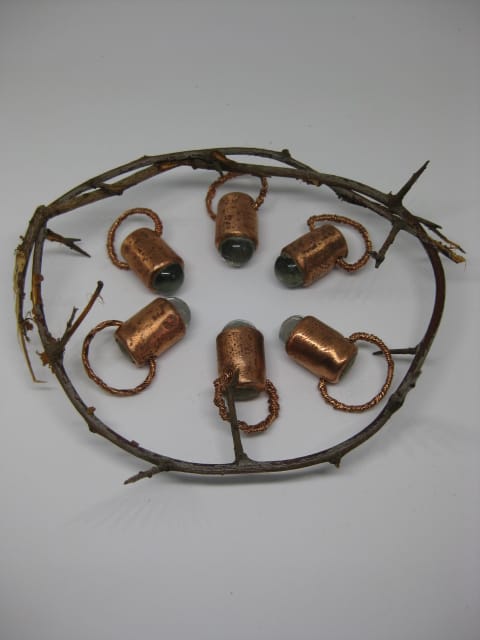
And yeah, I've started producing those and they're getting harder to find now because they are all being replaced now. So it's a finite resource. And that's kind of what I was thinking of when I wrote this story, setting it many, many years in the future. I'm wondering, will there still be any left in the roads in situ?
Julia: Yeah. So let's talk a little bit about your story. It's a really interesting story. I read it a few times, sort of trying to decide whether or not I felt like it was a good fit for Worlds of Possibility, which is fundamentally trying to invoke this sense of hope or comfort. And the story definitely posits a world where some kind of apocalypse exists, has happened, and we no longer have cars and people are not able to go very far in the world. I mean, it sounds like you say that they only travel on foot. So it's a very different sort of world than the one we're currently living in. And I was like, is that too dark? Or is that okay?
And I came down on the side of yes, obviously, it's okay, because I took it. But part of the reason was because I felt like, at heart, this was a sort of like cozy apocalypse where everybody in the story — which is only two people — are having a sort of emotional bond that strengthens over the course of the story and really kind of embracing the world that they live in now. The whole conversation about whether they miss the cars, but no, actually it's quieter now, and they like that. It sort of felt like, okay, this is kind of hopeful. It is kind of comforting, even though some kind of a great change has occurred, and that must have been traumatic and life must look very different now.
So I'm wondering if you want to tell me a little bit more about why that specific world, and what exactly you envision for how life works at that point.
Die: I mean, I think I've written this knowing the world we're living in now and how things are going and how it's all, like, a lot of the problems that we're facing now are, I wouldn't say due to, but definitely being exacerbated by and sort of facilitated by and motivated by tech, big tech, tech billionaires, and this push towards bigger tech controlling all of our lives, and pushing people apart. And the world seems to be getting sort of worse and worse in that respect. And also the kind of environmental impact of all of this as well.
And so I'm thinking this is some kind of apocalypse in which the aftermath allows the environment to recover. And also, more than that, I'm thinking, well, this is a story emphasizing the need now to really emphasize community and to be there for your immediate community, and for your friends, and create these smaller communities that exist in the real world, and building lasting friendships like these characters have. And the fact that this is a queer friendship as well that has lasted from childhood right up to later middle age, as the these characters are now.
So that's what I really wanted to explore and emphasize with this: just community over big tech, I suppose. But that kind of comforting, we can have our friends and we can have our communities, and that will get us through, and we will get through this and survive and rebuild after all of this.
Julia: Yeah, I love that message. And I feel like that's at the heart of why I eventually was like, yes, this story absolutely fits for what Worlds of Possibility wants to do, which is kind of remind people that there is hope, even in times when things are a little bit tricky, and definitely we're living through them. So...
Die: Yeah.
Julia: And I think the emphasis on community, and really, you are your community: you have to build it yourself and and tend to it. And this story is very much about the small moments of tending to your community.
Die: Yeah. Exactly. And this is why I love Worlds of Possibility. There's so much emphasis now, I think, in a lot of fiction, on like dystopia and so on. And I love that you're putting together something that's, you know, reality imitates art. So let's just hope.
Julia: Yeah, I mean, certainly, let's make it happen. I feel like we are the people who are going to have to rebuild, so we've got to start somewhere. And this is what I can do.
You mentioned that it's a queer friendship and that these people have been lifelong friends. They're now middle-aged. This is also part of the June issue. June in the United States is Pride Month. Many of the pieces in this issue feature queer narratives of some kind. For me, that's very important because I myself am queer. But I also really love to highlight a lot of different kinds of queer voices. And I know that in your writing, you also highlight a lot of different kinds of queer voices. Do you want to talk a little bit about that?
Die: Sure. I mean, when I first started out writing, I was writing cishet horror. Sort of the same sort of stuff as I'm writing now, but it was always kind of like straight couples, or straight people. Because really that's all I'd ever read and I didn't realise that you could write anything else And when I realised that I can just write ... you write what you know, you write the people that you know, you write about your community. Once I realised that my default could be the default for my writing, you know, it's like, why would you write like every single character being queer? And it's like, well, most of my friends are, so why wouldn't I write that?
So I've just sort of tried to write as much and as diverse representation of queer people as possible. And I'll continue to do that because I don't feel like I have all that much power in today's society, in the world, and I feel like one thing that I can do to make things a little bit better and a little bit more equal is at least just write loads of queer stories.
Julia: Yeah, absolutely. And I mean, I think everything that you're doing, every time someone else writes a queer story and it gets published, it gives a chance for someone else somewhere who maybe hasn't seen that written before to realize that that's a possible way of being.
Certainly when I was younger, I wasn't allowed to see the variety of queerness and the world around me that I can now. And I think kids in today's generation have so much more just accessible to them in the mainstream. It did not exist when I was a teen. I was just this tortured, closeted person.
Die: Yeah, same.
Julia: And I think if I had seen the possibility for all the different ways of being that I could see now, I might have had a very different experience.
Die: Yeah, I had exactly the same experience. There was just nothing. And then I think I was about 17 and discovered Poppy Brite and realised that there was media out there.
Julia: So much is context dependent. Because in some ways people are always like, oh, well, queerness has always been here and there's always been queer culture and there's always been queer media. And that's true, but it's also very context dependent on who you are, and where you're raised, and what kinds of things you're exposed to, and whether you realize that something is actually part of queer culture.
Die: Yeah. And whether you go to a church school in Ellesmere Port.
Julia: Yeah. So, hopefully by putting this all out there, we're adding to the collective, and hopefully that will create more opportunities for other people to see them. One of the other stories in this issue is about book burning, and it does not go as the people who burn the books intend. Instead the stories spread farther than they ever have before.
Die: Amazing.
Julia: I love that. That idea, sort of like, you can't burn it because it will keep spreading.
Die: Yeah. Fantastic.
Julia: You make these travel talismans out of the cats eyes.

Die: Yeah.
Julia: This is a second form of creative expression. So the first one would be writing. The second one is this physical crafting. Are those your two main modes or are you multi-creative in other ways as well?
Die: Oh, I do everything. I do a little bit of everything. What do they say? Jack of all trades, master of none. Mainly writing. And I do metal working, make jewellery, do a bit of wood carving, do a bit of sewing, do a bit of illustration, drawing, so anything really, just anything creative I love. Just producing physical things. Analog things.
Julia: You've just always been drawn to creative arts in general.
Die: Everything, I love it.
Julia: That's wonderful, and you've mentioned so many fascinating things, but the one that popped out to me is wood carving. How did you get into wood carving?
Die: Well, really just through walking. I love walking in nature. That's one of my favourite things to do, and just like picking up interesting sticks and going what can I make with this? And just kind of playing around and making stuff. It's all very professional, as you can tell.
Julia: So it's not something like formal lessons. You've just decided, I think wood carving could be fun. So I'm going to try it.
Die: Yeah, that's everything with me. I don't think I've had a formal lesson in anything. Oh, my mate taught me to crochet. I'm terrible at that, though.
Julia: Haha, okay. Well, tell us a little bit about your books.
Die: I've self-published one novel, which is Spirit Houses, which is way back in 2013 now. That was my first solo thing that I published. I had one co-edited anthology that me and a friend produced before that, which we had absolutely no idea what we were doing; we just did it for the love of it, and that was fun. That was called Revamp. That's out print now, though. But my first one was Spirit Houses, which is sort of an adventure horror novel that's Kingdom Hospital crossed with The Mummy, the Brendan Fraser film. So it's quite an adventure-y kind of soft horror.
I've got a few collections out. I did one called 365 Lies, which I wrote a flash fiction every day for the whole of 2012, think it was. No, 2013. It must have been 2013. And then that came out in 2014. All of the proceeds that go to the Motor Neurone Disease Association.
And I've got two short story collections. One's called Making Friends and one's called My Glass Is Runn. My Glass Is Runn is horror short stories. And Making Friends is sort of a terrible mixture of genres of horror and literary and just general just weird little stories — weird, queer little stories, I think I called it.
So they're all available, and I've got a novella called Cool S which is my most recent release. That's about the S thing we all drew in school and what it means and why it's terrible and cursed basically. So that's my back catalogue. I'm hopefully getting my first traditional publication next year with a really good publisher who I really admire. That'll be a collection of short stories all with transgender and non-binary protagonists.
Julia: Oh, that's exciting.
Die: So that should be 2026. But I don't want to say who it is because, you know, it's not all set in stone yet. But hopefully that'll come out, and it'll be out eventually anyway, one way or another.
Julia: Well, that's really exciting. So for anyone who's listening who is curious because they haven't actually encountered your work before this, where should they go to find more?
Die: Well, I have a website, which is diebooth.wordpress.com, and it's got all the information about all my published works, where you can get everything from. And also there's a page that's short stories that has links to all of my published short stories. There's a lot of them on there that are free to read online, so I would say if anyone wanted to check anything out, then have a read or have a listen to one of my of my stories that has been featured in Worlds of Possibility as well: this one and my previous one, "What It Takes to Stay Wild". So yeah, that's a way in, I think.
Julia: Well, thank you so much for coming and talking to me and reading your story. it was lovely getting to hear a little bit more about your background and the inspiration.
Die: Thank you so much for speaking to me today. I really appreciate the opportunity and it's just lovely to actually get to talk to you. Like we've worked together a few times and it's really, really nice to get to chat to you and I've really enjoyed it. Thank you so much.
About the Author and Artist
Die Booth is an indie author and editor who loves wild beaches and exploring dark places. When not writing, he enjoys making zines, and DJs alongside his boyfriend at Last Rites – the best (and only) goth club in Chester, UK. You can read his prize-winning stories in volumes from The Deadlands, Egaeus Press, Sans. PRESS and many others. His books, including his cursed novella Cool S are available online and he’s currently working on a queer coming-of-age folk horror novella. You can find out more about Die’s writing at http://diebooth.wordpress.com/ or say hi at Bluesky @diebooth.bsky.social
